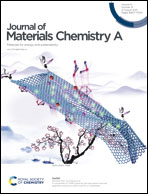Preparation, electrical and electrochemical characterizations of CuCoNiFeMn high-entropy-alloy for overall water splitting at neutral-pH†
Abstract
High entropy alloys (HEA), multicomponent (5 or more) alloys with an equiatomic or a near-equiatomic composition, provide a unique platform with which to engineer surface composition and active sites for the development of efficient electrocatalysts. Herein, we endeavor to introduce a high entropy alloy (HEA) of CuCoNiFeMn as an active model system for a bifunctional electrocatalyst at neutral-pH, synthesized by a room-temperature high-energy-milling process. The formation of a single-phased face-centered-cubic (fcc) HEA with homogenous distribution of each element was confirmed. In neutral electrolyte (PBS, pH 7.4), as-synthesized HEA shows promising performance, i.e., long-term durability for over 20 h, an overpotential of −320 mV vs. the reversible hydrogen electrode (RHE) for the hydrogen evolution reaction, and 680 mV vs. RHE for the oxygen evolution reaction at high current densities, which are lower than for other controlled electrocatalysts as well as being comparable with reported nanostructured electrocatalysts. Besides, HEA shows much smaller electrical and charge transfer resistance values than its controlled un-alloyed counterpart. Our preliminary results could open a new insights to developing nanostructured HEAs that could be used as efficient electrocatalysts in a neutral water splitting system, thus increasing hydrogen production viability.



 Please wait while we load your content...
Please wait while we load your content...